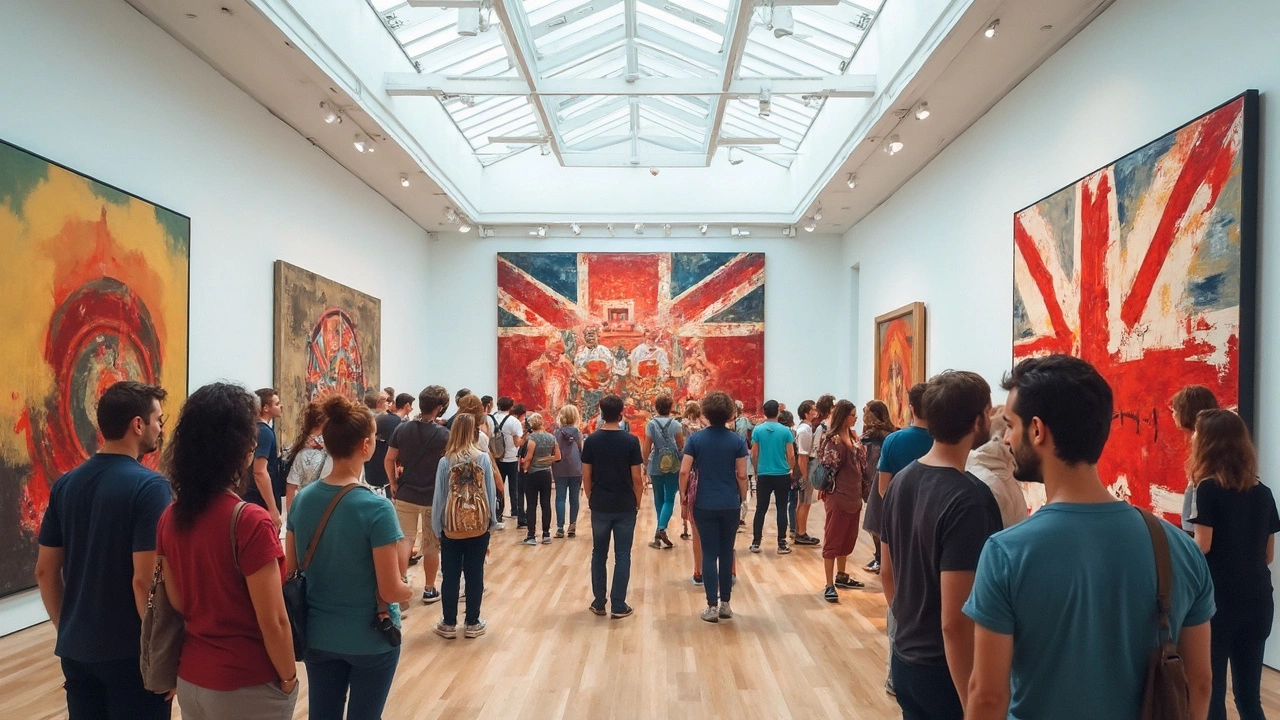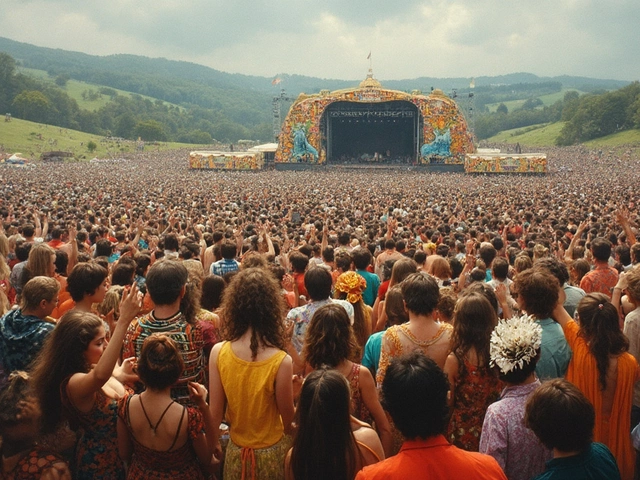When you look at a banana taped to a wall or a giant inflatable dog in a gallery, do you ever wonder why people crowd around, snap photos, and say they love it? It’s not just hype—there’s real fuel behind the fascination with contemporary art.
People are wired for novelty, and contemporary art thrives on turning old ideas on their head. Unlike those classic oil paintings you see at grandma’s house, this kind of art speaks your language—it’s got memes, tech, and stuff that feels familiar right now. It tells stories about what's happening in the real world, sometimes with a sense of humor, sometimes with a jab.
But what really sucks people in is the chance to interpret things in their own way. You don’t need a degree to have an opinion about a blinking light on a plinth or a painting that looks like pure chaos. Your view can be just as valid as the artist’s, and that freedom feels good. If you’ve ever felt out of place in a museum, contemporary art practically invites you in, daring you to react, question, or just say what you see—no need to fake it.
- What Exactly Is Contemporary Art?
- Breaking the Rules—Why That Matters
- Escaping Everyday Life
- Defining Your Own Meaning
- Controversy: The Love-Hate Factor
- Tips for Getting Into Contemporary Art
What Exactly Is Contemporary Art?
When people talk about contemporary art, they mean the art that’s being made right now, or at least from the 1970s up to today. It’s different from modern art—which stops around the time disco started and punk bands took the stage. Contemporary art is what’s being produced by living artists, and it deals with life as we know it.
This isn’t about fancy gold frames or endless portraits of kings. Instead, you’ll see anything from digital collages and installations that fill entire rooms, to performance pieces and weird sculptures. It’s not even all paintings anymore. Sometimes, it doesn’t look like “art” at all, at least not in the way most people grew up thinking about it.
To give you an idea of how much this scene has exploded, here’s some quick data:
| Fact | Detail |
|---|---|
| Estimated value of global contemporary art market (2024) | $19 Billion |
| Top artists' sales at auction in 2024 | Jean-Michel Basquiat: $81 Million |
| Number of major contemporary art fairs worldwide | 300+ |
Contemporary art often tackles big topics—think climate change, technology, social justice, or identity. This isn’t just background decoration; it’s meant to make you feel, think, or sometimes even squirm in your seat.
If you’re not sure what you’re looking at, you’re not alone. That’s pretty normal. Even collectors and critics argue about what counts as contemporary art. Here’s a quick way to spot it in action:
- The artist is (or was recently) alive.
- The work talks about things happening in the world right now, like tech, politics, or culture.
- You see new materials—like video, plastics, living plants, or virtual reality.
- No single style; the vibe can be anything from super-minimalist to wild and chaotic.
This open, flexible approach is what draws so many people in. You don’t need to get all the references; just reacting to it is part of the experience.
Breaking the Rules—Why That Matters
Ever see a painting and think, “Is that even art?” That reaction is exactly what pushes contemporary art into the spotlight. It’s all about breaking the rules, stepping away from what you think art is supposed to be. Andy Warhol put soup cans in a gallery. Banksy spray-paints on public walls. Artists like Yoko Ono invite you to help finish the artwork. These aren’t accidents—they’re big, deliberate moves.
Why does this matter so much? For one, it opens up art to more people. There’s no secret handshake. Suddenly, art isn’t just pictures in a gold frame. It’s interactive, weird, sometimes confusing—on purpose. When artists break the old rules, they shut out the idea that only a certain group can ‘get’ art. The vibe is: if you see it, you’re part of it.
There’s real impact when artists ditch traditions. Did you know that after Marcel Duchamp put a urinal in a gallery back in 1917, people argued for years over what should be counted as art? According to a 2022 survey by Statista, about 66% of museum-goers said contemporary art helped them see the world in a new way—mostly because it doesn’t follow the old playbook.
| Famous Rule-Breakers | Year | Rule Broken |
|---|---|---|
| Marcel Duchamp | 1917 | Everyday objects as art |
| Jackson Pollock | 1947 | Poured and splattered paint |
| Damien Hirst | 1991 | Animals in formaldehyde |
| Banksy | 2000s | Street art in galleries |
Here’s what you can try: Ask yourself, “Is this breaking a rule I expect?” If the answer’s yes, think about what the artist might be challenging. Sometimes, just spotting the broken rule tells you a lot about the message behind the work.
So, next time someone shrugs and says, “My kid could do that,” remember—it’s not about skill, it’s about seeing what happens when the normal rules get tossed out the window. That’s how contemporary art keeps everyone guessing, and why it never gets boring.
Escaping Everyday Life
Ever feel like your days blend together? The average adult in the US spends about 7 hours a day staring at screens, according to a 2024 Nielsen study. That leaves a lot of folks looking for fresh ways to break the routine. Here’s where contemporary art comes in—it’s a ticket out of the usual, full of surprises that jolt your brain awake.
Art exhibits today aren’t just about passive looking. Immersive art shows like those from teamLab or Yayoi Kusama’s Infinity Rooms pull you right into another world. In big cities, digital art museums and pop-up installations are everywhere. Visiting these places, people report feeling less stressed and more creative, even if just for an hour or two. A survey from the UK’s Arts Council in 2023 reported that 72% of visitors said contemporary art made them forget their worries, at least temporarily.
Here’s what makes it all work:
- Interactivity: Many installations invite you to touch, move, or even be part of the artwork. That physical engagement gets your mind off daily stresses.
- Unexpected experiences: You might walk through a fog tunnel, get lost in a mirrored room, or sit inside a giant fabric tent. It’s weird, memorable, and miles away from work emails.
- Fresh visuals: The brain loves novelty. Bright colors, odd shapes, moving images—these catch your attention and can shake off “autopilot” mode.
Here’s a quick glimpse at recent stats about escaping with art:
| Source | Finding |
|---|---|
| UK Arts Council (2023) | 72% reported less stress after a contemporary art visit |
| Nielsen (2024) | Average screen time: 7 hours daily |
| Pew Research (2022) | 56% visit art spaces hoping to "feel something different" |
So next time life feels stuck on repeat, try an art gallery. Even ten minutes in front of something wild and unexplainable can give your brain the break it’s looking for.

Defining Your Own Meaning
This is where contemporary art really stands out—it puts you in the driver’s seat. You don’t have to guess what an artist from 300 years ago was trying to say. Instead, you get to make your own sense of what’s in front of you. Whether it’s an empty room, a routine object turned upside down, or a chaotic mix of shapes and colors, the point is that your reaction matters.
Take the famous piece “The Physical Impossibility of Death in the Mind of Someone Living” by Damien Hirst—a 14-foot shark in a tank of formaldehyde. Some visitors remember feeling fear, others thought about nature, and some just wondered if the shark smelled weird. The artist set the stage, but you fill in the blanks. This isn’t just a gimmick. According to a 2023 survey by Artsy, 67% of people said they value art more when they feel free to give it their own meaning instead of being told what it “should” represent.
Museums and galleries have noticed. Guided tours are getting shorter, leaving room for your comments and questions. New York’s MoMA even runs workshops encouraging visitors to argue about art, not agree on some textbook answer.
- If you want to get more out of your gallery trip, try skipping the wall labels at first. See how the art hits you before getting the “official” story.
- Compare your thoughts with a friend, even if you totally disagree. Sometimes the weirdest ideas spark the best insights.
- Don’t sweat it if something seems pointless—it might stick in your brain later. That “wait, what?” feeling is actually part of the fun.
Some museums have started tracking what themes, ideas, or emotions visitors write down in comment books next to new works. Here’s a quick look at the top things people mention when giving art their own meaning:
| Theme/Emotion | % of Visitor Mentions (2024, US Museums) |
|---|---|
| Personal memories | 37% |
| Social issues | 30% |
| Humor/Absurdity | 19% |
| Confusion/Curiosity | 10% |
| Anger/Upset | 4% |
Your take might not match anyone else’s—and that's the whole idea. The door’s wide open for you to step up, react, and let art mean whatever makes sense for you.
Controversy: The Love-Hate Factor
There’s no denying it—contemporary art gets people seriously worked up. Some walk out of galleries buzzing, while others leave shaking their heads or even annoyed. This mix of love and hate is actually what keeps the whole scene alive.
Think back to when the artist Maurizio Cattelan duct-taped a banana to a wall and sold it for $120,000 at Art Basel Miami in 2019. That one piece sparked headlines, laughter, rants, and endless memes. It’s not the only example, either. When Banksy’s painting "Girl With Balloon" shredded itself the moment it sold at auction, the room went wild. Half the crowd thought it was genius, the other half thought it was a prank gone too far.
What’s going on here? Part of it comes down to expectations. People walk into a museum expecting skill and tradition. Instead, they see a bunch of stuff that doesn’t look like "art" to them. That gap between expectation and reality stirs up debate—and that’s good for the art. A heated discussion means the work has actually done its job: it got your attention and got people talking.
Here’s a quick look at how controversy has helped contemporary art capture the public eye:
| Famous Controversy | Year | Outcome |
|---|---|---|
| "Fountain" by Marcel Duchamp | 1917 | Redefined what could be art; changed the art world forever |
| "My Bed" by Tracey Emin | 1999 | Nominated for the Turner Prize; got people debating personal boundaries |
| Banana duct-taped to the wall | 2019 | Sold for $120,000; exploded on social media |
| Banksy’s self-shredding painting | 2018 | Value doubled, became a cultural icon |
So what’s the big tip here? If you find yourself rolling your eyes at a piece, try sticking around to eavesdrop on what others are saying. These heated reactions are part of the fun. Whether you’re inspired or outraged, you’re part of a conversation that has no right or wrong answer.
Tips for Getting Into Contemporary Art
Let’s be real: stepping into a contemporary art gallery can make you feel clueless, especially when you see something you might think is “just a bunch of junk.” But trust me, you can actually have a good time and even enjoy it if you know how to jump in. Here’s how you can make the most of your experience with contemporary art—without feeling lost.
- Don’t Overthink It. If a piece makes you laugh, cringe, or think, that’s enough. Your real reaction counts. Don’t try to hunt for the "right answer." Most artists actually want you to bring your own viewpoint.
- Read the Wall Texts. Before skipping the label, give it a shot. Even a few sentences can clue you in on what inspired the artist or what’s going on in the world at the time.
- Ask Questions. If you spot a curator, docent, or even a security guard (they see everything), ask them which work is their favorite or what gets the weirdest reactions. Their stories can make you see stuff in a new light.
- Check Out More Than Museums. Hit up pop-up shows, street art walks, even public installations. Contemporary art isn’t just locked up in galleries anymore—cities everywhere have murals and open spaces alive with art.
- Try the Audio Guide or App. Many museums now let you scan a QR code for background audio, videos, or short artist interviews. It’s a low-pressure way to get the backstory while you wander at your own speed.
- Take Someone With You. Sometimes, all it takes is a friend’s reaction to change how a work feels. My wife Althea once spotted a hidden detail in a sculpture that I walked right by. Fresh eyes make the experience better.
Ever wonder how much folks are really engaging with contemporary art? Here’s a quick look:
| Country | Percentage of Population Visiting Contemporary Art Museums (2024) |
|---|---|
| USA | 22% |
| UK | 17% |
| Japan | 15% |
| Germany | 14% |
| Australia | 12% |
If you’re not in the stats yet, you’re definitely not alone—and it’s never too late to start. Every year, more cities host "first Saturdays" and free art nights. So don’t stress about getting it all at once. Dive in, keep an open mind, and let the surprises hit you. That’s the best way to get into contemporary art and actually enjoy it.







